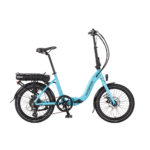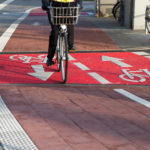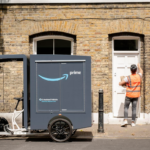I'd like to attempt a long distance ride (the Coast to coast, 220 miles) with my daughter when she gets back from the USA after her world tour. Ideally with some cycle camping thrown in. My preliminary research has damped my enthusiasm for taking the pedelec. I'm not sure I'd get up those hills in the Lake District. Before I splash out on a Thorn Raven I'd be glad to know if anybody has more positive experience of this route on a pedelec. My bike is a Technium step through. Panasonic drive.
Coast to coast on a Pedelec?
- Thread starter thingaby
- Start date
If it's the Technium with a 7 or 8 speed hub gear, it can climb anything but using those gears, but if a 3 speed it isn't entirely suitable. I haven't done the ride in that area but have plenty of very steep hill experience elswhere on Panasonic powered bikes.
You have to provide the usual proportion of the effort of course, but by taking your time at moderate speeds it is possible.
On gentle to average slopes a powerful hub motor bike can be faster climbing and less work for you, but on the steepest parts a hub motor struggles, which is where the drive through gears system wins.
Recharging frequency could be the biggest problem since the range will fall with lots of hill climbing.
.
You have to provide the usual proportion of the effort of course, but by taking your time at moderate speeds it is possible.
On gentle to average slopes a powerful hub motor bike can be faster climbing and less work for you, but on the steepest parts a hub motor struggles, which is where the drive through gears system wins.
Recharging frequency could be the biggest problem since the range will fall with lots of hill climbing.
.
I'll be doing it in September but the battery and motor will not be coming with me.
It's only 140 miles though, not 220. You can actually do it in about 80 miles if you go more directly from the Solway Firth to Tynemouth but then you'd be missing the whole point of the ride!
Good luck with the trip.
It's only 140 miles though, not 220. You can actually do it in about 80 miles if you go more directly from the Solway Firth to Tynemouth but then you'd be missing the whole point of the ride!
Good luck with the trip.
On the subject of recharging the battery -if my wife acted as support team with the car (setting up the camp site etc) do you think the car battery used with an inverter could recharge my bike battery each evening without taking too much juice out of the car battery? We've got an automatic so no bump starting.
This depends to some extent on the car battery capacity and the e-bike battery voltage and capacity, but it will probably drain the battery far too much unless you run the car engine at the same time to replenish the charge.On the subject of recharging the battery -if my wife acted as support team with the car (setting up the camp site etc) do you think the car battery used with an inverter could recharge my bike battery each evening without taking too much juice out of the car battery? We've got an automatic so no bump starting.
The watt hours will give you some idea:
Typical 12 volt car batteries have from 540 to 660 watt/hours of content, but they can't deliver all of it due to a factor known as the Peukert effect.
A Panasonic system 26 volt 10 Ah battery is 260 watt/hours.
A Wisper 37 volt 14 Ah battery is 518 watt hours.
You can see the first would heavily drain the battery and leave starting questionable with theoretically only half charge left and not able to freely deliver it all.
The second case would completely flatten the car battery.
Run the car engine for much of the time while charging and you should be ok if the car is in good working order.
.
True, I didn't even bother to show how much worse that made the prospect, chargers also typically 80 to 85% efficient.Yes, not forgetting an inverter is...what 85% efficient...and the charger also not 100% efficient...
The average car alternator should easily keep pace with charging current and losses when the engine is left ticking over though, but best to do a check of battery willingness to start the car after an hour or so when first trying this.
Maybe a dry run at home would be a good idea if trying out charging with engine ticking over.
.
Probably rather worse than that. I have some info on the Wisper charger, which isn't wonderful:True, I didn't even bother to show how much worse that made the prospect, chargers also typically 80 to 85% efficient.
The average car alternator should easily keep pace with charging current and losses when the engine is left ticking over though, but best to do a check of battery willingness to start the car after an hour or so when first trying this.
Maybe a dry run at home would be a good idea if trying out charging with engine ticking over.
.
Peak true wattage input is around 150 watts, though it doesn't hold that for long. The power factor is not good though - best case 0.58 to 0.6 when the charger is running at maximum power, dropping to around 0.52 when the battery is approaching a full charge.
This relates to a maximum VA of around 250, which would make an inverter work pretty hard considering that the charger output current limits at (I think) about 2.5 amps at 42 volts. That's around 105 watts coming out for 150 going in, or 70% efficient, even forgetting about the poor power factor.
Most inverters for 12V to mains use 'double conversion' which maximizes efficiency and you can get 80-85% efficiency towards full load. However, a poor power factor load will knock a big hole in this.
When rating computer power supplies, which are rather more complex switch-mode jobs than the Wisper charger, these days the manufacturers aim for better than 85% efficiency (to comply with one of the Euro directives) and a good power factor - as close to 1 as possible - and often 0.8 or better. So, the charger for an e-bike is probably cutting some corners in design and construction, though of course there will be some which are electrically better than others.
The bottom line here is that you'd probably need a large car battery in decent condition to recharge a much smaller ebike battery via a mains inverter and the official charger. The transfer taken as a whole could well be less than 50% efficient.
Rog.
Yes, that wouldn't surprise my Rog. I used the most favourable example of a charger's efficiency, the current Panasonic one used on their 10 Ah li-polymer battery. I's be disappointed with any mix of inverter/charger/battery that got down to 50% loss, but certainly the losses can be very high.
Luckily as remarked, an alternator can make all the difference though.
.
Luckily as remarked, an alternator can make all the difference though.
.
Related Articles
-
 MTF Enterprises announces acquisition of EMU Electric Bikes
MTF Enterprises announces acquisition of EMU Electric Bikes- Started by: Pedelecs
-
 Wisper 806T folding bike wins Which? ‘Best Buy’
Wisper 806T folding bike wins Which? ‘Best Buy’- Started by: Pedelecs
-
 Sustrans calls for protected cycle lanes
Sustrans calls for protected cycle lanes- Started by: Pedelecs
-
 Amazon launch their first UK e-cargo micromobility hub
Amazon launch their first UK e-cargo micromobility hub- Started by: Pedelecs


